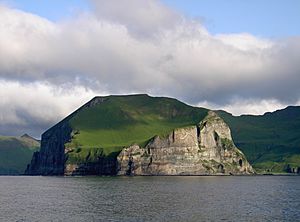Cape Lutke (Alaska) facts for kids
Cape Lutke is a special piece of land that sticks out into the ocean. It's called a headland. You can find it on Unimak Island, which is the biggest island in the Aleutian Islands. These islands are part of Alaska, a U.S. state. Cape Lutke is located on the middle part of Unimak Island's southern coast.
Contents
Exploring Cape Lutke's Location
Cape Lutke is a natural landmark on Unimak Island. This island is the largest in the long chain of islands known as the Aleutian Islands. The Aleutians stretch out into the Pacific Ocean from the mainland of Alaska.
Where is Unimak Island?
Unimak Island is part of the Aleutians East Borough, Alaska. This area is known for its wild beauty and unique wildlife. The island is also home to Shishaldin Volcano, one of the most active volcanoes in the Aleutian chain.
What is a Headland?
A headland is a high piece of land that extends out into a sea or lake. Think of it like a nose on a face, but for the land! They are often rocky and can be important for navigation.
The Many Names of Cape Lutke
This interesting headland has had a few different names over time. Each name tells a bit about its history and who explored the area.
Named After an Explorer
The name Mys Litke was given to this headland in 1847. It was named by the Imperial Russian Hydrographic Service. They named it after a famous Russian explorer, Count Fyodor Petrovich Litke.
Who was Fyodor Petrovich Litke?
Fyodor Petrovich Litke was a Russian navigator, geographer, and explorer. He made many important voyages and discoveries. The name "Litke" is the Russian way of saying "Lütke," which is a German name. It became "Lutke" when it was written in English.
Other Historical Names
Cape Lutke was also known by other names. In 1852, Captain Mikhail Dmitrievich Tebenkov called it Mys Sivuchiy. This Russian name means "Sealion Cape."
Cape Promontory
Later, in 1888, the U.S. Bureau of Fisheries (USBF) gave it another name: Cape Promontory. The USBF was a government agency that studied and managed fish and wildlife.


